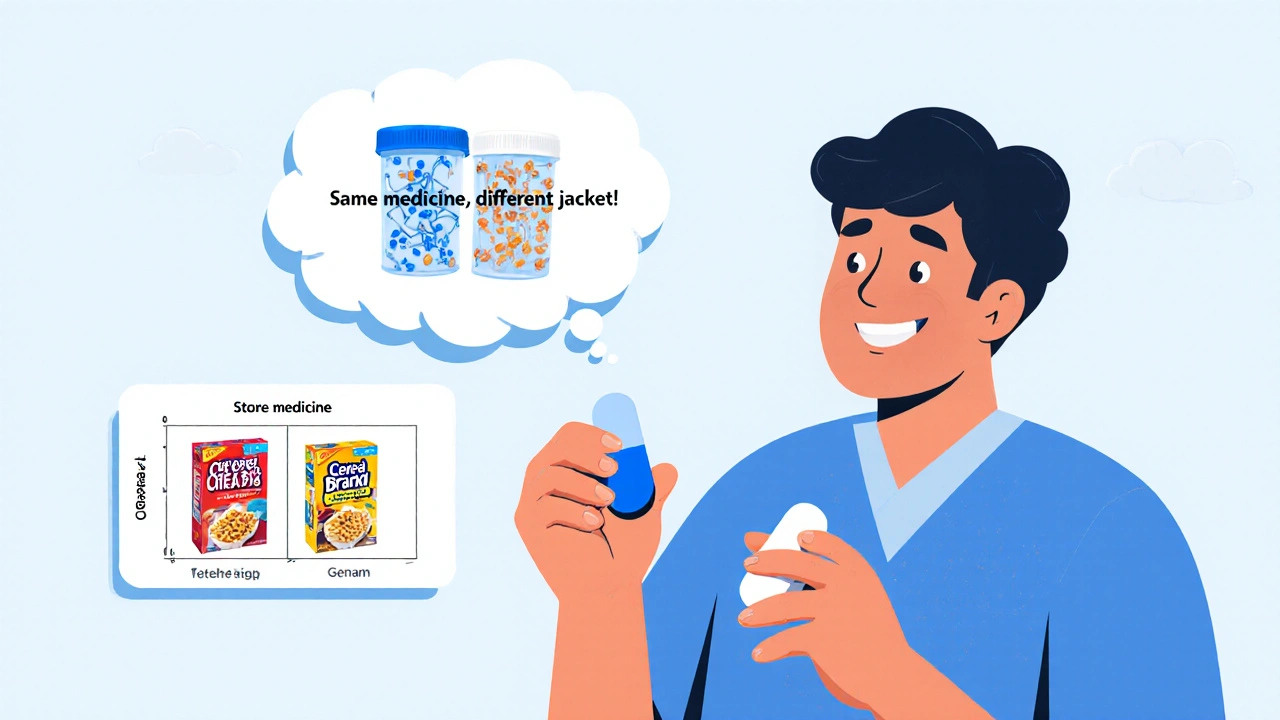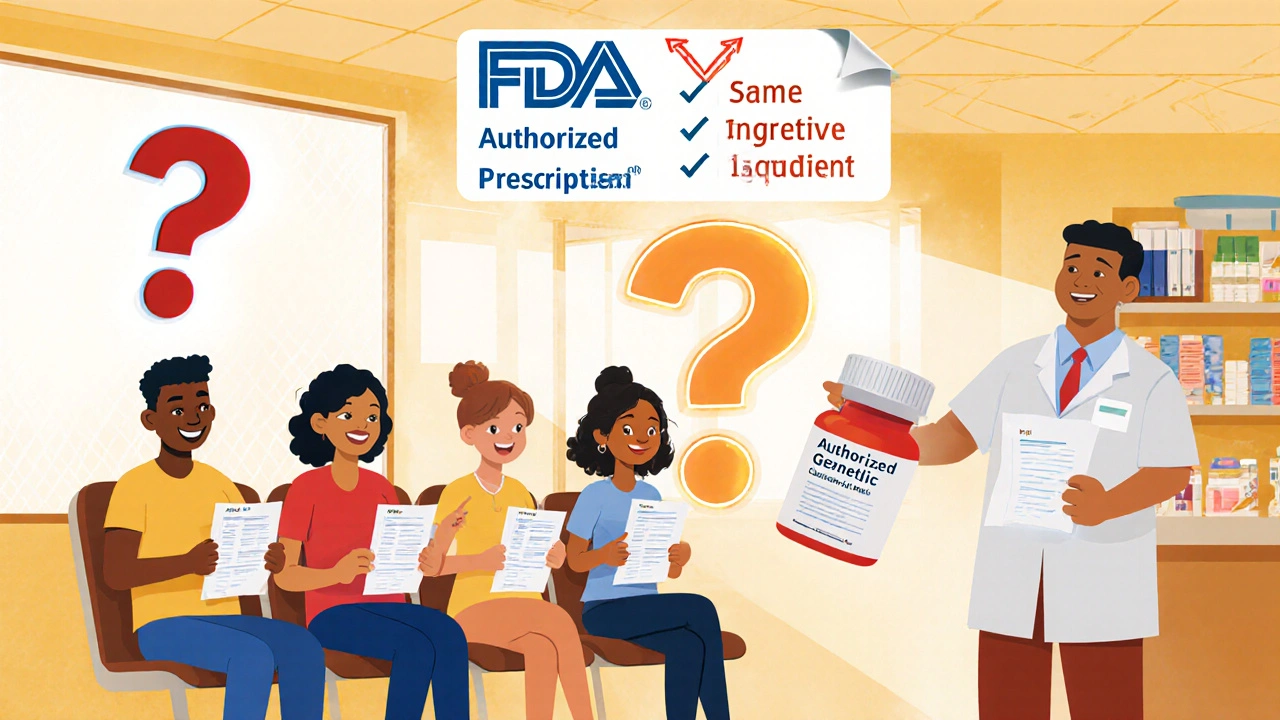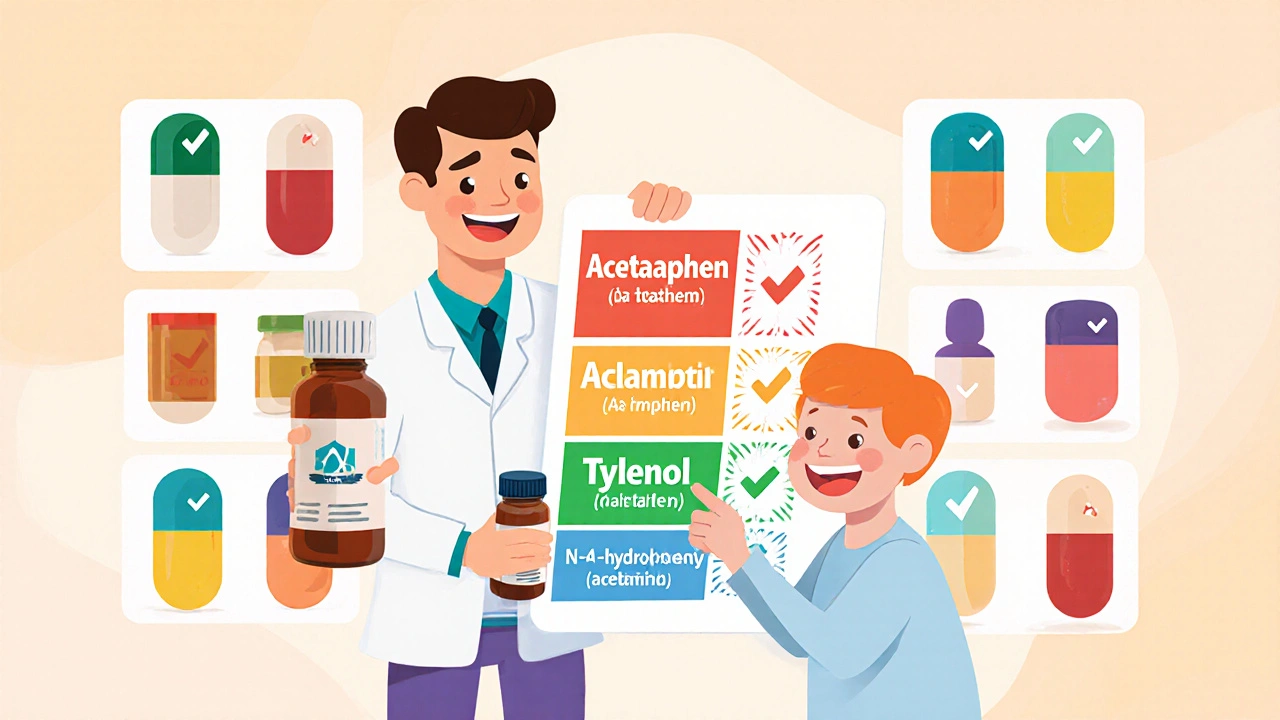Most people don’t realize that generic drugs are the same as brand-name medicines - not just in price, but in how they work. Yet, nearly 4 out of 10 Americans still think generics are weaker, less safe, or don’t work as well. Why? Because the information they’re given is either too technical, confusing, or just plain missing.
Here’s the truth: if your doctor prescribes a generic version of your medication, you’re getting the exact same active ingredient, in the same strength, with the same effect. The FDA requires it. But if you’ve ever looked at a pill bottle and seen a different color, shape, or name than what you’re used to, it’s no wonder you’re confused.
What Exactly Is a Generic Drug?
A generic drug is not a copy. It’s not a knockoff. It’s the same medicine, made to meet the same strict standards as the brand-name version. The FDA says a generic must have the same active ingredient, strength, dosage form (tablet, capsule, liquid), and route of administration (swallowed, injected, applied to skin) as the original. It must also work the same way in your body.
The key word here is bioequivalence. That means the generic delivers the same amount of medicine into your bloodstream - within 80% to 125% - as the brand-name drug. That’s not a guess. It’s a scientifically proven range tested in real people. In fact, 98.7% of the 11,000 generic drugs approved between 2010 and 2020 passed this test.
What’s different? The color. The shape. The fillers inside the pill - like lactose or cornstarch instead of sugar. These don’t affect how the medicine works. They’re just there to make the pill easier to swallow or to hold its shape. Think of it like buying store-brand cereal. The main ingredient - oats, sugar, flavor - is the same. The box looks different. The price is lower. But it still fills your bowl the same way.
Why Do People Doubt Generics?
Confusion starts with language. Pharmacies hand out sheets with words like “bioavailability,” “pharmacokinetics,” and “therapeutic equivalence.” Most patients don’t know what those mean. A 2021 study found that standard patient handouts were written at a 10th-grade reading level. But consumer language guides? They’re written at a 6th-grade level - the level the NIH says is best for health materials.
And then there’s the myth that “if it looks different, it must be different.” A patient who’s been taking a blue pill for years gets a white one and thinks something’s wrong. They stop taking it. Or worse - they go back to the more expensive brand-name version.
Real stories back this up. One 2021 study tracked 450 people on generic levothyroxine (for thyroid issues). Over half said they felt worse - even though blood tests showed their levels were fine. They stopped the medicine. Why? Because they didn’t understand that small changes in how the body absorbs the drug can happen with any version - brand or generic - and aren’t always a sign the drug isn’t working.
What Makes a Good Consumer Language Guide?
The best guides don’t just simplify. They clarify. They answer the questions patients actually ask:
- “Is this really the same?”
- “Why does it look different?”
- “Will it make me feel the same?”
- “Can I switch back and forth?”
Effective guides use analogies people already understand. “Tylenol is to acetaminophen like Kleenex is to tissues.” That’s clear. That sticks.
They also use visuals. Side-by-side photos of brand and generic packaging. A chart showing the same active ingredient listed under three names: chemical name (N-(4-hydroxyphenyl) acetamide), generic name (acetaminophen), brand name (Tylenol). One survey found 82% of pharmacists said this simple chart cut confusion in half.
And they don’t overpromise. They don’t say “all generics are exactly the same.” Because they’re not - not always. For drugs like warfarin (blood thinner), levothyroxine (thyroid), or phenytoin (seizure control), tiny differences in how the body absorbs the drug can matter. That’s why some doctors recommend sticking with one brand or generic version - not because generics are bad, but because consistency matters.
Good guides say that. They say: “For most medicines, switching is fine. For these few, your doctor might suggest staying with one version.” That honesty builds trust.

Who Makes These Guides - And Are They Reliable?
The most trusted guides come from the FDA. Their “Generic Drug Facts” page, updated every quarter since 2010, is the gold standard. It’s written plainly, includes real examples, and is reviewed by doctors, pharmacists, and patient advocates. It scores 87 out of 100 on a tool that measures how easy health materials are to understand.
Pharmacies like CVS, Walgreens, and Walmart now use the FDA’s framework in their own patient handouts. They train pharmacists to spend just 90 seconds explaining generics using three key points:
- The active ingredient is the same.
- The effect on your body is the same.
- You save an average of $387 per prescription.
That’s it. No jargon. No fluff. Just facts.
But not all guides are created equal. Some commercial ones are written by marketers, not doctors. They’re flashy but vague. One 2022 study found that only 62% of pharmacy-generated materials met basic health literacy standards. The FDA’s version? 87%. That gap matters.
What About Authorized Generics?
Here’s something most people don’t know: some “generic” drugs are actually the exact same pill as the brand-name version - just sold under a different label. These are called authorized generics. They’re made by the original drug company, under a generic name. No changes. No fillers swapped. Just cheaper.
They’re especially helpful for people who’ve had bad experiences switching to a regular generic. A 2020 analysis found that patients who switched to authorized generics had 28% fewer returns to the brand-name drug. That’s because they didn’t have to adjust to a new pill shape, color, or even the way it felt in their throat.
Good language guides now mention authorized generics. Not as a trick. As a choice.

Why This Matters - And What’s Changing
Generic drugs saved the U.S. healthcare system nearly $2 trillion between 2009 and 2019. In 2022, 90.9% of all prescriptions filled were generics. Yet, they made up only 22.3% of total drug spending. That’s the power of plain language.
But confusion still costs money. The Association for Accessible Medicines estimates that $3.2 billion a year is spent on unnecessary brand-name prescriptions because patients don’t understand generics.
That’s why things are changing. In 2023, Medicare mandated that all Part D plans provide standardized, easy-to-read generic education materials by January 2025. The FDA launched a $4.7 million initiative to create special guides for high-risk drugs like levothyroxine and warfarin. And Kaiser Permanente is testing AI tools that tailor explanations based on a patient’s reading level and medication history.
By 2026, 60% of generic education may come directly from your electronic health record - showing you exactly why your new pill is safe, even if it looks different.
What You Can Do
If you’re on a generic drug and feel unsure:
- Ask your pharmacist: “Is this the same as the brand?” They can show you the FDA’s comparison chart.
- Ask: “Is this an authorized generic?” If yes, you’re getting the exact same pill, just cheaper.
- Don’t stop taking it because it looks different. Check the active ingredient on the label. It should match your old pill.
- If you feel different - and it’s a drug like thyroid, seizure, or blood thinner - tell your doctor. Don’t assume it’s the generic. It could be something else.
And if you’re helping someone else - a parent, an older relative - explain it like this: “It’s the same medicine, just without the fancy name and price tag.”
Generics aren’t second-best. They’re the smart choice - if you know how to use them.
Are generic drugs really as effective as brand-name drugs?
Yes. The FDA requires generic drugs to contain the same active ingredient, in the same strength and form, and to work the same way in your body. They must deliver the same amount of medicine into your bloodstream - within a scientifically proven range of 80% to 125% of the brand-name version. Over 98% of approved generics meet this standard. They’re not weaker. They’re not cheaper because they’re less effective. They’re cheaper because they don’t have the marketing, advertising, or patent costs of brand-name drugs.
Why do generic pills look different from brand-name ones?
By law, generic drugs can’t look exactly like the brand-name version. That’s to avoid trademark issues. So the color, shape, size, or markings on the pill may be different. But the active ingredient - the part that treats your condition - is identical. The differences in appearance are just in the inactive ingredients, like dyes or fillers, which don’t affect how the medicine works.
Can I switch between different generic brands?
For most medications, yes. Switching between different generic versions is safe and common. But for drugs with a narrow therapeutic index - like warfarin, levothyroxine, or phenytoin - small changes in how your body absorbs the drug can matter. In those cases, your doctor may recommend sticking with one brand or generic version to keep your levels stable. Always talk to your doctor or pharmacist before switching if you’re on one of these medications.
What’s an authorized generic?
An authorized generic is the exact same drug as the brand-name version - made by the same company - but sold under a generic label and at a lower price. It’s not a copy. It’s the real thing, just without the brand name. These often have the lowest switch-back rates because patients don’t notice any difference in how the pill looks or feels. Ask your pharmacist if your generic is an authorized one.
Why do some people say generics don’t work for them?
Sometimes, it’s not the drug - it’s the change. Switching from a familiar pill to a new one - even if it’s the same medicine - can cause anxiety or a nocebo effect, where you feel worse because you expect to. Other times, it’s a real issue with a specific generic version. For example, in 2012, the FDA pulled one generic version of Wellbutrin XL because it didn’t meet bioequivalence standards. That’s rare. But if you feel worse after switching, talk to your doctor. Don’t assume it’s the generic. It could be something else - or you may need a different version.
Where can I find reliable information about my generic drug?
The best place is the FDA’s official “Generic Drugs” webpage, updated quarterly. It includes plain-language explanations, comparison charts, and lists of authorized generics. Your pharmacist can also show you the medication guide that comes with your prescription - if it’s from a reputable pharmacy chain, it’s likely based on FDA guidelines. Avoid relying on drug company websites or random blogs. Stick to government or nonprofit sources like the FDA or the Academy of Managed Care Pharmacy.

Iives Perl
lol they’re all just lab experiments with different packaging. 🤨 I swear the blue pill made me dream about aliens. Now I get a white one and my cat won’t stop staring at me. Coincidence? I think not.
Savakrit Singh
The bioequivalence threshold of 80%–125% is statistically robust, yet insufficient from a pharmacokinetic precision standpoint. The intra-subject variability in Cmax and AUC0–t is often underreported in consumer-facing materials, leading to a false sense of therapeutic equivalence. A 2023 meta-analysis by the Indian Journal of Pharmacology highlights significant inter-generic variability in sustained-release formulations, particularly for narrow-therapeutic-index agents.
Jebari Lewis
I’ve been researching this for months. The FDA’s data is solid, but here’s the thing: most people don’t know that ‘bioequivalence’ doesn’t mean ‘identical.’ It means ‘close enough.’ And for drugs like levothyroxine, ‘close enough’ can mean your TSH goes from 2.1 to 5.8. I switched generics three times. Each time, my fatigue got worse. I went back to brand. My doctor didn’t care. The system doesn’t care. But I’m still alive because I didn’t trust the label.
sharicka holloway
My grandma used to cry because her thyroid pill changed color. She thought the pharmacy gave her the wrong medicine. I sat with her for an hour, showed her the FDA chart, and told her it’s like switching from blue jeans to black ones-same fit, different look. She started taking it again. That’s what good info does. No jargon. Just care.
Alex Hess
This whole article is corporate PR dressed up as public service. The FDA is a revolving door for pharma execs. You think they care about your ‘trust’? They care about profit margins. Generics are cheaper because they skip clinical trials. That’s not ‘the same medicine’-it’s a loophole.
Leo Adi
In India, we call this ‘patent expiry magic.’ Same pill, different box. My uncle took a generic for hypertension and said he felt ‘lighter.’ I asked why. He said, ‘Because the tablet is smaller now.’ I told him it’s the same dose. He didn’t believe me. We all trust what we see. Not what we read.
Melania Rubio Moreno
i think generics are sus tbh. why do they look so weird? like someone made them in a garage. also i swear my anxiety got worse after switching. maybe its the fillers?? idk but i’m going back to brand name. #trusttheprocess
Gaurav Sharma
The 98.7% approval rate is misleading. It ignores post-market adverse event reports. In 2021, over 12,000 complaints were filed with the FDA regarding generic levothyroxine. Yet, no recall occurred. Why? Because the agency prioritizes cost over safety. This is systemic negligence.
Shubham Semwal
You people are delusional. If generics were truly equal, why do pharmacies charge more for authorized generics? Because the drug company knows you’ll pay extra to avoid the ‘weird pill.’ This isn’t about science-it’s about psychological comfort. And you’re all just buying the lie.
Jauregui Goudy
I’m a pharmacist in Ohio. I see this every day. A 72-year-old woman comes in crying because her new pill is oval instead of round. She thinks she’s being poisoned. So I pull up the FDA chart, show her the active ingredient matches, and say: ‘This is your medicine. Just without the fancy name.’ She hugs me. That’s why this matters. Not because of data. Because of people. We need more of this. Not less.